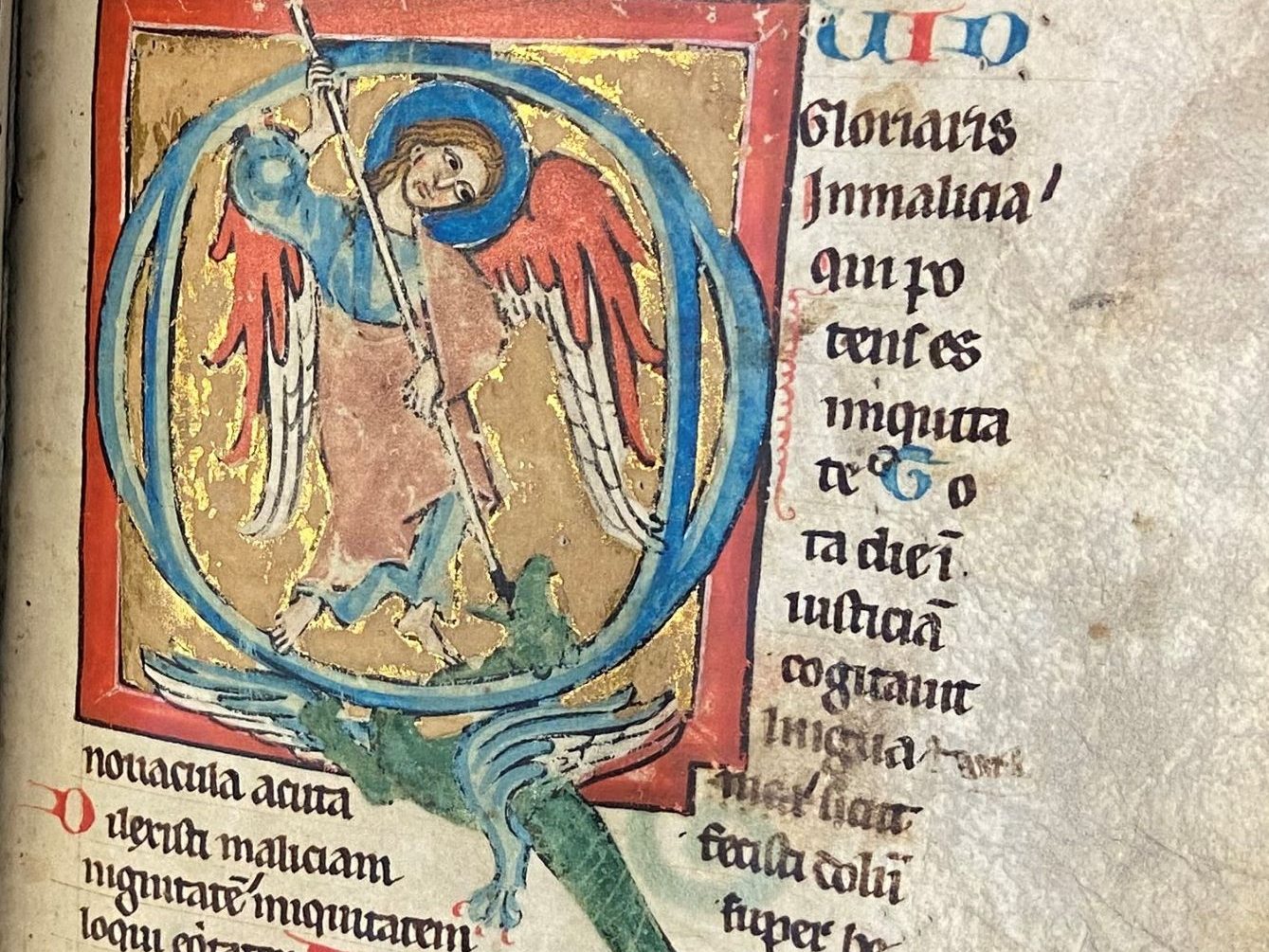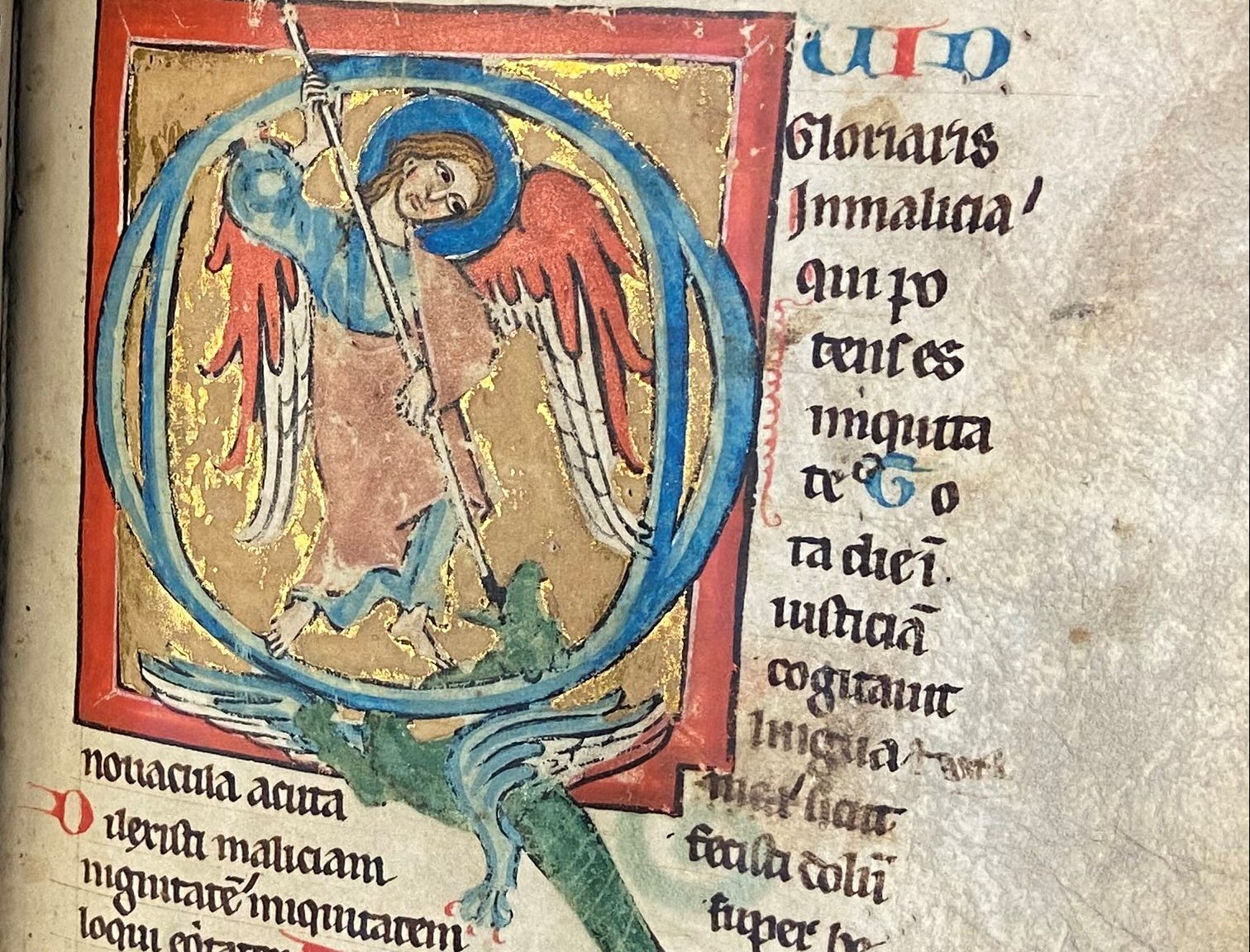If you’re like me, then the task of approaching a medieval manuscript like the Constance Psalter from Southern Germany is a daunting one. Apart from its six-figure price tag, the look, language and organization of the manuscript feel foreign in the hands of a self-proclaimed modernist like myself. Upon opening the Psalter for the first time, I was struck by how distant I felt from the manuscript: its metal clasps, bosses, and the gloves required to touch them appeared to hold secrets, while its use of Latin–incomprehensible to me without a translation–promised to keep those secrets safe.
And yet, there was something on the page that I instantly recognized: a dragon! Suddenly, I found myself personally invested in the Psalter before me; in the face of something familiar, my brain began to race with questions and potential answers. Perhaps that’s why illuminations like that of St. Michael slaying this dragon in the historiated ‘Q’ intrigue me so much: they offer a way for an outsider to understand the significance and power of medieval texts.
When I allowed my initial Ooh! Dragons! reaction to settle, I discovered in its place a blooming curiosity to understand the text in a deeper way. I figured: if this image can invoke such a powerful transformation of thought in me—a 21st century observer with no context nor personal connection to this Psalter— then what could it have done for dedicated medieval readers in the 1200s? Such a nagging curiosity led me to the monastic reading process of lectio divina.
Lectio divina, or “divine reading” in English, is a simple term for an utterly exhaustive process consisting of lectio, or the initial reading of the religious text, meditatio (meditation), oratio (prayer), and contemplatio (contemplation) (Robertson xvii). As Dr. Joseph Dyer explains in “The Psalms in Monastic Prayer,” this process required monks to stand, arms outstretched, and recite some 150 Psalms a day, every day, to a particular tempo (Dyer 60). The average reader might chalk this up to the extreme religious dedication expected of a monk and declare lectio divina a tiresome and uninspired fulfillment of duties, but the average reader would be wrong.
In fact, despite its apparent rigidity, lectio divina is far from a restrictive or monotonous process, let alone a purely medieval and monastic one (we’ll touch on this later). While early monastic rules took the definitions of the four steps at face value, their meaning expanded with time to reflect the intimate, individual investment that lectio divina demands (Robertson xiv). In the case of meditatio, a term used to describe the repetition, memorization, and recitation of scripture in the church, it began to reflect a “digestion” of the text and a personalized “spiritual experience” (205-207). Thus, an “active engagement of the mind” that connects the monk’s individual experiences with his Psalms is what carries out the process of true divine reading (Dyer 64).
As the Christian monk and celebrated theologian John Cassian once said:
‘Certainly [the monk] thinks of [the Psalms] as having been specially composed for him and he recognizes that what they express was made real not simply once upon a time in the person of the prophet but that now, every day, they are being fulfilled in himself.’
(Dyer 64).
This idea of personal application and emotional fulfillment is widely echoed in the literature on lectio divina because the Psalms’ content primarily deals with humanity’s relationship to God and what kinds of emotions this relationship incites in us. As such, lectio divina does not merely ask of its monks repetition, memorization and practice, but a deeper, “intimate dialogue with a living, present, divine interlocutor” tailored to the individual’s soul and pursued daily (Robertson xii).

What can this dialogue accomplish for the monk, you ask? Beyond religious growth and fulfillment, the Psalms a monk successfully memorized through such a ruminative process could serve as protection from demons and temptation (Dyer 61). This is where Michael and his dragon come in. As Dr. Kathleen Openshaw describes it, though the illuminations of medieval Psalters rarely illustrated the specific words of each particular Psalm, they served as a generalized weapon in the religious individual’s daily battles of spiritual warfare against sin and evil. This is because the historiated initials portrayed “image[s] of conflict between good and evil” that could accommodate the varied content of countless Psalms and inspire readers with images of religious victory (Openshaw 26-27). In the case of our Psalter, St. Michael’s appeal as the archangel and intermediary between humanity and God makes this illumination especially impactful: his violent slaying of the dragon (a common biblical symbol for Satan and evil more generally) promises monks that God and his archangel will protect them too for their righteousness (Johnson 10).
As powerful as the lectio divina process must have been for monks in medieval times, its legacy and accessibility have not left us today. Modern ethnographic findings declare that the practice of lectio divina is alive and well in monasteries. Moreover, its contemporary interpretation as a moment of careful analysis, contemplation, listening, emotional inventory and a “conversation with God” makes it more accessible—and perhaps even relatable—than ever (Irvine 399).
In reading Cassian’s quote once more, we now arrive at a modern parallel. After all, what is emotionally moving and fully realized art, song, and literature if not media that feels “specially composed for [us]”? I suggest that the lectio divina process has never left us, but has lingered in the same way that good art must. The lessons of lectio divina, then, live in the everyday so long as we are willing to open our minds alongside our books.
Featured image: The archangel Michael slays a dragon in this historiated ‘Q’ that opens Psalm 51 (Vulgate numbering) (Fol. 37r, Les Enluminures TM 789 https://www.textmanuscripts.com/medieval/medieval-german-psalter-79751)
Works Consulted
Dyer, Joseph. “The Psalms in Monastic Prayer.” The Place of the Psalms in the Intellectual Culture of the Middle Ages, edited by Nancy Van Deusen, SUNY Press, 1999. EBSCOhost, pp. 59-89. https://search.ebscohost.com/login.aspx?direct=true&AuthType=ip,shib&db=e000xna&AN=5633&site=eds-live.
Irvine, R. D. G. “How to read: Lectio divina in an English Benedictine monastery.” Culture and Religion, vol. 11, no. 4, pp. 395-411, DOI: 10.1080/14755610.2010.527614
Johnson, Richard F. Saint Michael the Archangel in Medieval English Legend. Boydell & Brewer, 2005. JSTOR, http://www.jstor.org/stable/10.7722/j.ctt81w52. Accessed 22 Nov. 2022.
Les Enluminures, MS TM 789 https://www.lesenluminures.com/artworks/categories/4/9620-psalter-c.-1240-60/.
Openshaw, Kathleen M. “Weapons in the Daily Battle: Images of the Conquest of Evil in the Early Medieval Psalter.” The Art Bulletin, vol. 75, no. 1, 1993, pp. 17–38. JSTOR, https://doi.org/10.2307/3045930. Accessed 22 Nov. 2022.
“Psalter.” Medieval Text Manuscripts, Les Enluminures, https://www.textmanuscripts.com/medieval/medieval-german-psalter-79751.
Robertson, Duncan. Lectio Divina: The Medieval Experience of Reading. Collegeville, Liturgical Press, 2011.
Weston, Jenny. “Historiated Initials: Letters with a Story to Tell!” Medievalfragments, WordPress, 21 Mar. 2014, https://medievalfragments.wordpress.com/2014/03/21/historiated-initials-letters-with-a-story-to-tell/. Accessed 4 Dec. 2022.
